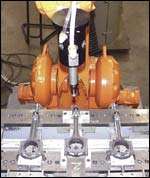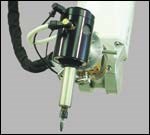Flexible Finishing Fits Automated Cells
Radially compliant tool facilitates robotic deburring
“We develop totally automated, self-contained metals finishing cells for a wide variety of industries, and we are constantly looking for new systems and components that will improve efficiency,” says Charlie Young, Manager/Advanced Automation, Hammond Roto-Finish. “Using an extremely flexible finishing tool allows us to solve several design and robotic training challenges in work cells.”
Young is talking about Flexdeburr, a patent-pending robotic finishing tool developed by ATI Industrial Automation. “The flexibility and consistency of the finishing tool allows us to design more efficient cells with a smaller footprint. Also, the system’s robot is quicker and easier to program with a more forgiving finishing tool,” he says.
Featured Content
Hammond Roto-Finish is a turnkey solution house that provides a variety of finishing systems, including automatic robotic, cylindrical and flat, as well as a wide assortment of heads customized to suit specific finishing processes. Originally known as the W.E. Hill Co., Hammond was launched in 1881 to produce sawmill equipment for the lumber industry. After World War I, the company developed grinding and polishing machines. W.C. Hammond purchased the company in 1926, and it is in the third generation of family-owned management.
Hammond has provided finishing equipment for the automotive, aircraft, aerospace, medical goods, sporting equipment, decorative hardware, jewelry, musical instrument, and household appliance industries. “Our systems are very specialized, and while we may use the same technology, i.e. industrial robots, from industry to industry, we consider all of our systems custom made,” Young explains.
Improvements Always Welcome
“Automating finishing operations is extremely difficult to accomplish with the required degree of quality,” says Young. “Often, part complexity and the robot’s capability to generate a path exactly equivalent to the part edge make it difficult for the finishing operations to meet overall quality goals. When we first tried ATI’s radially-compliant Flexdeburr device, we were pleasantly surprised how closely it mimicked a manual finishing operation. Also, the device is more forgiving, allowing us to quickly and easily change directions. This is especially important during the robot training period.”
According to Young, compliance at the tool tip saves robot programming time by allowing programmers to input fewer path points. “Tool compliance will accommodate deviations between the robot path and the part edge, so the robot path does not have to precisely follow the part edge,” he explains. “Programming savings are multiplied in applications where multiple passes are necessary in order to achieve a desired finish.”
Young points out that any reduction in programming time is important. “When you consider a total system, from design to manufacture to run-off to installation to operator training, may take six months or longer, any step in the process that can save time will be investigated,” he says.
Programming the robot path is achieved by mounting either a dowel pin of the same diameter as the cutting tool, or a pointed teaching tool in place of the actual cutting tool. The robot is manually moved to a point where the dowel or pointed tool is touching the edge of a finished part, and the point is recorded. This is repeated at intervals along the edge of the part, and the robot controller uses these recorded points to define the path to be followed.
Cutting force is also adjustable on-the-fly, allowing the programmer to increase force in areas having larger burrs or where more material must be removed. Programming of robot movements also depends on part complexity—complex parts require significant programming time to achieve acceptable robot paths.
Eliminating Manual Finishing
According to ATI, the Flexdeburr robotic finishing tool was developed to satisfy a wide range of automated finishing operations. The 40,000-rpm, air-turbine-driven tool can handle finishing of aluminum, plastics, steels, and other materials, even in tough to reach places. The lightweight, rotary tool gains radial compliance from air pressure applied to the shaft, which allows the tool to perform consistently on irregular part patterns.
The tool’s pneumatic motor/spindle assembly is mounted on a pivot bearing connected to the tool housing. This allows the pneumatic motor to move with the pivot bearing independently of the housing to provide ±0.31 inch (±8 mm) of radial compliance and maintain a constant finishing force.
The radial “compliance field” is created by a ring of small pneumatic pistons located near the front of the tool housing. The compliance force can be exerted on the spindle/tool in any direction radially from the tool. Finishing speed can be as fast as 1 to 3 ips on hard materials and up to 12 ips on soft materials.
Mounted to a robot or CNC machine, the tool requires clean, dry, filtered, non-lubricated air that can be directly vented into the workplace. It uses two air connections; one at 90 psi to spin the cutting file, and a second at 60 psi to apply the radial force. Regulated air pressure on the floating head provides the constant force needed to produce a good quality chamfer. The tool is extremely light, allowing it to hug the workpiece edge at a constant force even as the robot moves as fast as 12 ips along the edge of the part.
ATI says the long, thin envelope of the “working” end of Flexdeburr allows finishing in tight, deep, and generally hard-to-reach places. The entire tool weighs only 2.6 lb and can operate over a temperature range of 41-95°F. It uses standard tungsten carbide industrial bits that can be easily changed from one operation to the next.
A T I Industrial Automation




















